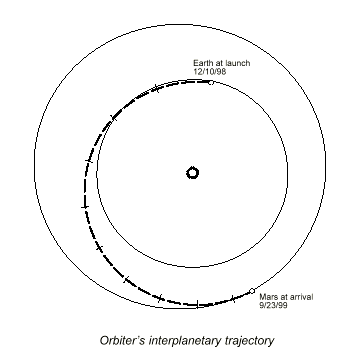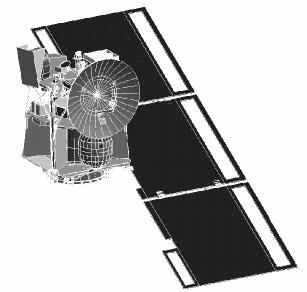 | |||||
|
 | |||||
|
Mars Climate Orbiter - Cruise Phase
Mars Climate
Orbiter MissionMission Overview
Launch
Dec, 11, 1998Cruise
Dec 11, 1998 - Sep 23, 1999Mars Orbiter Insertion
Sep 23, 1999Aerobraking
Sep 23, 1999 - Nov 25, 1999Lander Support
Dec 3, 1999 - Mar 1, 2000Mars Mapping
Mar 1, 2000 - Jan 15, 2002Relay
Jan 15, 2002 - Dec 1, 2004Assuming launch on December 10, the spacecraft will take 286 days or about nine and a half months to reach Mars, entering orbit on September 23, 1999. The spacecraft's flight path is called a Type 2 trajectory because it will take the orbiter more than 180 degrees around the Sun; this will result in a slower speed at Mars arrival. By comparison, Mars Pathfinder followed a Type 1 trajectory which took it less than 180 degrees around the Sun, reaching Mars in only seven months. During the first leg of its trip, Mars Climate Orbiter will fly slightly inward toward the Sun before spiralling out beyond Earth's orbit to Mars.

Orbiter's Interplanetary Trajectory

Mars Climate Orbiter In Cruise ConfiguationDuring the first phase of the cruise, the spacecraft will maintain contact with Earth using its low-gain or medium-gain antenna while keeping its solar arrays pointed at the Sun. For the first week, the spacecraft will be tracked 24 hours per day. During the second through fourth weeks after launch, the spacecraft will be tracked a minimum of 12 hours per day using 34-meter-diameter (112-foot) antennas of the Deep Space Network. During quiet periods of the interplanetary cruise, the orbiter will be tracked a minimum of four hours each day. The tracking rate will be increased again to 12 hours per day starting 45 days before the spacecraft reaches Mars.
Twelve days into flight, the radiator door on one of the science instruments, the Pressure Modulator Infrared Radiometer, will be moved to the vented position to acclimate the instrument's passive radiative cooler to the environment of space.
During interplanetary cruise, Mars Climate Orbiter is scheduled to fire its thrusters a total of four times to adjust its flight path. The first of these trajectory correction maneuvers will be carried out 10 days after launch. This maneuver, expected to be the largest and longest, will be used to correct launch injection errors and adjust the Mars arrival aimpoint. The maneuver is expected to take up to seven minutes to execute.
The remaining three trajectory correction maneuvers will be used to direct the spacecraft to the proper aimpoint at Mars. The maneuvers are scheduled 45 days after launch (January 25, assuming launch on December 10); 60 days before Mars arrival (approximately July 25); and 10 days before Mars arrival (approximately September 13).
Science instruments will be powered on, tested and calibrated during cruise. The Pressure Modulator Infrared Radiometer and Mars Color Imager will be calibrated during a week-long checkout 80 days after launch. During this checkout activity, the Mars Color Imager will be commanded to turn and scan across a specific star cluster as part of a star calibration exercise.
Eighteen days before arrival, the imager will take pictures of Mars that will be transmited to Earth over the following three days.
Mars Orbit Insertion
| Home | Mars Climate Orbiter | Mars Polar Lander | Deep Space 2 Microprobes |
| Welcome | Mailing List | Links | Credits |
For questions or comments on this website please refer to our list of contacts.